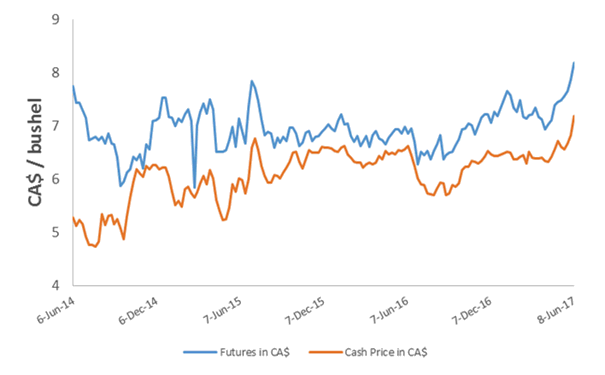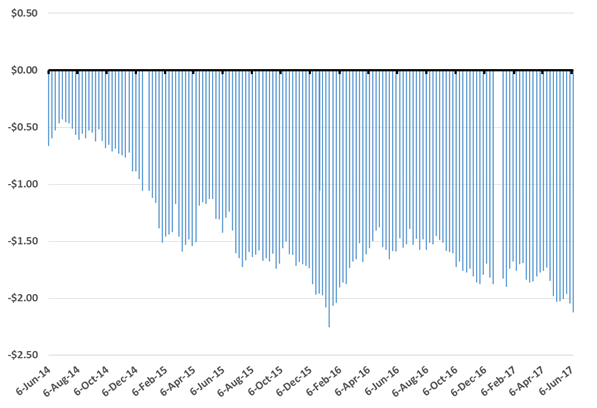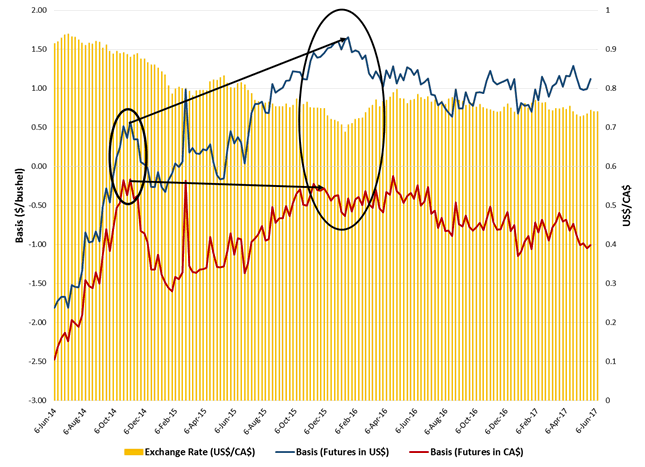| | Basis varies between grain company locations and between grain companies, and it is used by them to meter a commodity into their handling system. Simply, grain companies will adjust their basis to attract or deter grain delivery commitments. Basis is easy to calculate for a product like canola. Canola has a futures market that trades in Canadian dollars so the comparison of cash to futures is easy. The most common grade for harvested canola is #1 and that is the base grade for the canola futures contract.
Wheat pricing is not so simple. There are several types of wheat, each with different uses. Pricing of hard red spring wheat is particularly complex as there are several grades and each grade can have several protein levels with premiums or discounts. Additionally, although there is a milling wheat futures contract listed by International Currency Exchange (ICE) Canada futures, it does not actively trade. Therefore, those in the grain trade have chosen to use the Minneapolis Hard Red Spring Wheat futures for hedging Canadian hard red spring wheat. The Minneapolis wheat futures is a US dollar contract. Therefore, in comparing the price of our Canadian hard red spring wheat to the Minneapolis futures, the currency difference needs to be accounted for. Most grain companies operating in Western Canada are quoting hard red spring wheat basis in Canadian dollars and they are listing that basis as the difference between the local cash price and the US-denominated Minneapolis futures price. Grain companies are stating that the currency difference is accounted for as part of their basis.
Here is an example of basis calculated without an exchange rate adjustment to the futures price.
CA$ 5.71/bu. (Central Alberta area CWRS wheat cash bid)
- US$ 5.87/bu. (Minneapolis Grain Exchange (MGEX) March wheat futures)
CA$ -0.16/bu (Basis)
Here is that same example with the futures price converted to Canadian dollars with the exchange rate at 80 cents per US dollar.
CA$ 5.71/bu. (Central Alberta area CWRS wheat cash bid)
- US$ 7.34/bu. (Minneapolis Grain Exchange (MGEX) March wheat futures)
CA$ -1.63/bu (Basis)
Calculating the basis using currency-adjusted futures results in a dramatically different result, especially with a weak Canadian dollar exchange rate. For those grain buyers that do not calculate the basis in this way, it is important that producers make the exchange rate adjustment in comparing basis levels of different companies. For reference, the following are graphs of Central Alberta upper grade hard red spring wheat prices and basis levels since June 2014.
Figure 1. Cash vs. Futures Price for Upper Grade CWRS Wheat – Central Alberta

Figure 2. Basis Difference in US$ Quoted Futures vs. CA$ Adjusted Futures for Upper Grade CWRS Wheat – Central Alberta

Understanding how wheat basis is reported is important for producers to understand before they enter into contracts. Some key questions to ask are: What currency is the basis in ‐‐ Canadian dollars or US dollars? When the basis contract is settled against a futures position, is the contracted basis applied directly to the US denominated futures, or is it applied after the US denominated futures is converted to Canadian dollars? In other words, from the time that basis contract was signed, does a change in the Canadian dollar exchange rate also affect the final price, or is the US futures price the only factor that can affect the final cash price?
The graph below shows two different methods of calculating basis. The blue line shows the unadjusted basis used by most grain companies. The red line converts MGEX futures to Canadian dollars first and then subtracts the Canadianized futures from the cash price – an adjusted basis.
Figure 3. Basis Exchange Rate Adjusted vs. No Adjustment for Upper Grade CWRS Wheat – Central Alberta

This currency-adjusted futures calculation method is the standard for calculating livestock basis levels, where US futures prices are also used. In livestock basis contracts, currency is not part of basis. Therefore, a cattle basis contract does not lock in the currency, leaving that aspect open unless locked in otherwise.
Here is an example using the graph above, with reference to the area in black ovals. At the beginning of November 2014, you can see that the unadjusted basis value (blue line) was around 0.53 over the futures price. January 2016 unadjusted basis levels were about 1.50 over. During that interval, the unadjusted basis fluctuated significantly and strengthened from 0.53 over to 1.50 over. However, during the same time period the adjusted basis value (red line) shows an opposite trend. The adjusted basis has actually weakened from 0.21 under to 0.50 under. The two different methods for calculating basis display opposing trends as shown by the black arrows in the above chart.
Comparing the two methods of calculating basis is not simple. Remember that grain companies who quote the basis without adjusting the futures for exchange rate state that the currency exchange is contained within their basis. Therefore, they may suggest that adjusting the futures to Canadian dollars is at least a partial duplication of the currency effect.
The execution of a basis contract may differ from one company to the next, so it is good business to ask your questions and understand the answers before signing the contract.
|
|